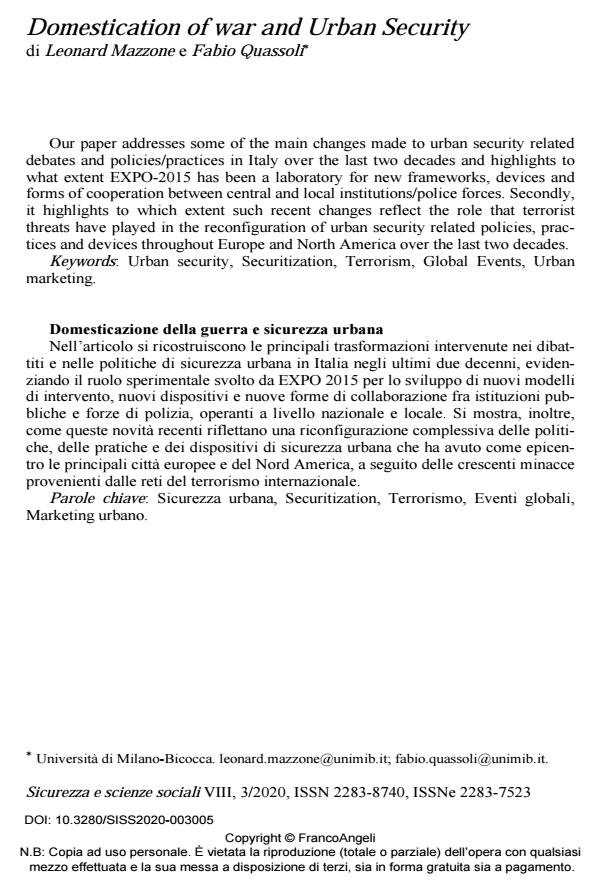Domestication of war and Urban Security
Titolo Rivista SICUREZZA E SCIENZE SOCIALI
Autori/Curatori Leonard Mazzone, Fabio Quassoli
Anno di pubblicazione 2021 Fascicolo 2020/3
Lingua Inglese Numero pagine 22 P. 36-57 Dimensione file 247 KB
DOI 10.3280/SISS2020-003005
Il DOI è il codice a barre della proprietà intellettuale: per saperne di più
clicca qui
Qui sotto puoi vedere in anteprima la prima pagina di questo articolo.
Se questo articolo ti interessa, lo puoi acquistare (e scaricare in formato pdf) seguendo le facili indicazioni per acquistare il download credit. Acquista Download Credits per scaricare questo Articolo in formato PDF

FrancoAngeli è membro della Publishers International Linking Association, Inc (PILA)associazione indipendente e non profit per facilitare (attraverso i servizi tecnologici implementati da CrossRef.org) l’accesso degli studiosi ai contenuti digitali nelle pubblicazioni professionali e scientifiche
Our paper addresses some of the main changes made to urban security related debates and policies/practices in Italy over the last two decades and highlights to what extent EXPO-2015 has been a laboratory for new frameworks, devices and forms of cooperation between central and local institutions/police forces. Second-ly, it highlights to which extent such recent changes reflect the role that terrorist threats have played in the reconfiguration of urban security related policies, prac-tices and devices throughout Europe and North America over the last two decades.
Nell’articolo si ricostruiscono le principali trasformazioni intervenute nei dibat-titi e nelle politiche di sicurezza urbana in Italia negli ultimi due decenni, eviden-ziando il ruolo sperimentale svolto da EXPO 2015 per lo sviluppo di nuovi modelli di intervento, nuovi dispositivi e nuove forme di collaborazione fra istituzioni pub-bliche e forze di polizia, operanti a livello nazionale e locale. Si mostra, inoltre, come queste novità recenti riflettano una riconfigurazione complessiva delle poli-tiche, delle pratiche e dei dispositivi di sicurezza urbana che ha avuto come epicen-tro le principali città europee e del Nord America, a seguito delle crescenti minacce provenienti dalle reti del terrorismo internazionale.
Parole chiave:Sicurezza urbana, Securitization, Terrorismo, Eventi globali, Marketing urbano.
Leonard Mazzone, Fabio Quassoli, Domestication of war and Urban Security in "SICUREZZA E SCIENZE SOCIALI" 3/2020, pp 36-57, DOI: 10.3280/SISS2020-003005